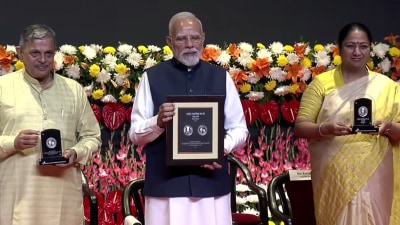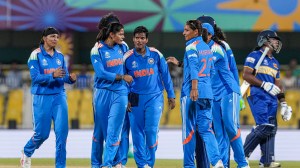Joker in the Pack
WHY did he do it? Why did Palaniappan Chidambaram impose that infernal eight per cent excise duty on playing cards? Does he have some sort o...

WHY did he do it? Why did Palaniappan Chidambaram impose that infernal eight per cent excise duty on playing cards? Does he have some sort of fetish for puritanism? Zero sense of fun? See gambling as a pastime that should have gone out with the Mahabharat? Fume because an AIADMK politician beat him at rummy? Is the finance minister really so hard up as to tax the poor little taash ki patti?
Far from the heavyduty budget analyses, these are questions eating into Hasmukhbhai. They’ve also sent chartered accountants of India’s playing card manfacturing industry — an obscure business if ever there was one but one with a steady 10 to 12 per cent profit margin year after year — into an almighty tizzy.
Hasmukhbhai — Hasmukh Jain to be precise — sits scratching his hair in his downbeat office in Pune. He’s the manager of Bhandari Marketing, Pune’s biggest wholsesale dealer of playing cards, still recovering from the Chidambaram stealth tax.
The eight per cent excise was first proposed in 1982. In 22 years the idea had been all but forgotten. This year, in a budget packed with nostalgia for old days, old ways, Chidambaram plucked it out of memory.
So if you’ve been buying a pack of cards for Rs 10, be ready to pay Rs 10.80.
It seems trivial, doesn’t it? Even obscure. You’re probably wondering why you’re reading this. Simple: Chidambaram’s given the chance to peek into one of India’s least-known business sectors. The one that means fun and games for us — and a fortune for Hasmukhbhai.
Each week, the Pune card dealer — er, literally and otherwise — brings in 25 cartons of playing cards from suppliers in Mumbai. Each carton contains 144 packs, tightly packed so that not an inch is wasted. That’s a neat 3,500 odd packets disbursed every week.
|
How the cards stack up
|
|||||
|
Story continues below this ad |
|||||
| Big markets: Maharashtra (sales peak during the 10-day Ganesha festival); Kerala (bird designs are hot, especially during Onam); Delhi (Diwali sees market high); Andhra Pradesh (farmers’ pastime during sowing season) Big makers: Eighty per cent in Mumbai, 10 per cent in Daman, some in Delhi Price per pack: Begins at Rs 5 or 10, could go up to Rs 80 if you prefer custom designs, imported paper. Top-end plastic cards can set you back by Rs 1,000 a set. India packs in: Well, 60 to 70 million card packs are made here every year Export zones: From the US Army to African gambling dos, the Indian card travels. But Las Vegas casinos are a bit of a final frontier. The Chinese got there first Sixty per cent: The level of subsidy Indian makers say the Chinese government gives its card exporters. Compare that to ol’ Chidambaram’s eight per cent excise. |
|||||
‘‘We buy them at about two to three per cent below MRP. With the eight per cent excise, the industry has informally decided that manufacturers will take four per cent of the burden and wholesalers the other four per cent.’’ Consumers will be spared the PC — playing card but it may as well be be P. Chidambaram — hike.
To bulk card buyers that is some saving. Take the card room of the Poona Club, Hasmukhbhai’s biggest customer, buying 720 packs a month. Says Laxmi Narayan, purchase manager at the club, ‘‘It comes to Rs 22 per pack for the KIM Deluxe variety we use.’’
The Indian card market is quite price sensitive. Balbir Singh, proprietor of Jagat Singh and Sons, supplier of playing cards to Chandigarh’s best-known clubs and taash parties, sells some 1,800 packs a month. Bulk buyers ask for heavy discounts. ‘‘Preferred brands like American Club, priced at Rs 23 per pack in the market, are sold to clubs at Rs 12 to 15.’’
While Chandigarh and Punjab have among India’s most fervent playing card users, local manufacture is unknown. Favourite brands like American Club, American Express, Gold Bond and Heera-Panna — all in the Rs 20-25 range — are trucked in from Mumbai or Delhi. Custom-designed cards or those made from imported paper can go up to Rs 50 or even Rs 80 a pack.
So much for the worm’s eye view. What’s the big story? About five million card packs are manufactured every month in India by a closely-held cartel of 30-odd companies. The export market is a major thrust area (see accompanying story) — though the inscrutable, innumerable Chinese are a perennial threat.
Cards are printed on paper and plastic-paper combos — ranging from the upper end black-centred art board to, down the value chain, blue-centred and white-centred board.
An astronomical 1,350 metric tonnes of material is converted into playing cards every month, industry sources say. Seventy to eighty tonnes of this raw material is plastic-based, the rest is paper.
While the big card makers are spread across Mumbai, Delhi and Daman — thanks to local tax breaks — the paper-making, the back-end of the supply chain, is a north Indian preserve. Ballarpur Industries Ltd (BILT), the Thapar Group’s paper arm, is a big player, with the ITC family’s Bhadrachalam Paperboards also in the race.
Bilt sources confirm their company has ‘‘approximately 60 per cent market share’’ in the card paper business. Top quality paper is supplemented by imports, says Atul Sehgal of Print Masters India — Delhi’s card king — from France, Italy and Germany.
The big money is in exports. ‘‘We can grow even 1,000 per cent a year,’’ says an industry insider, ‘‘if we are given the right incentives.’’ While Indian cards do turn up on occasion, the casinos of Monte Carlo and Las Vegas are serviced by Chinese and, to a degree, South Korean cards.
One Indian card magnate visited a competitor in China and was surprised to find a ‘‘small scale unit’’ employing 7,500 people. In contrast, Indian companies have a staff barely touching three figures.
Other than playing cards, the export market consists of collectibles — such as cards featuring photographs of sports personalities or celebrities — cards with family pictures, top-of-the-line gift packs.
Today, India has only a small slice of that pie. Some day it will change. Some day, the finance minister will play his ace, pack off his joker. Some day the cards will turn out right.
— with



- 01
- 02
- 03
- 04
- 05




























